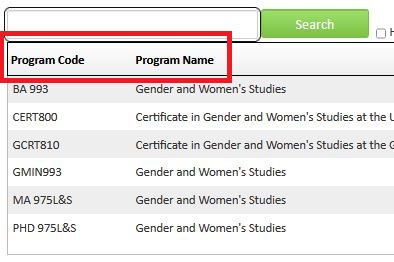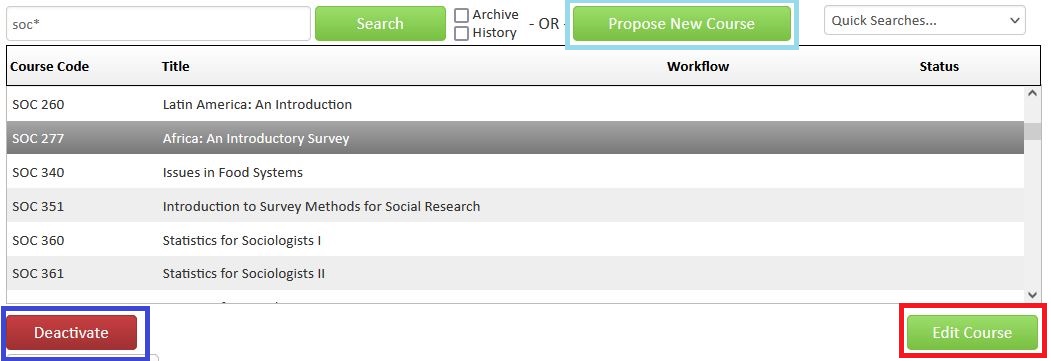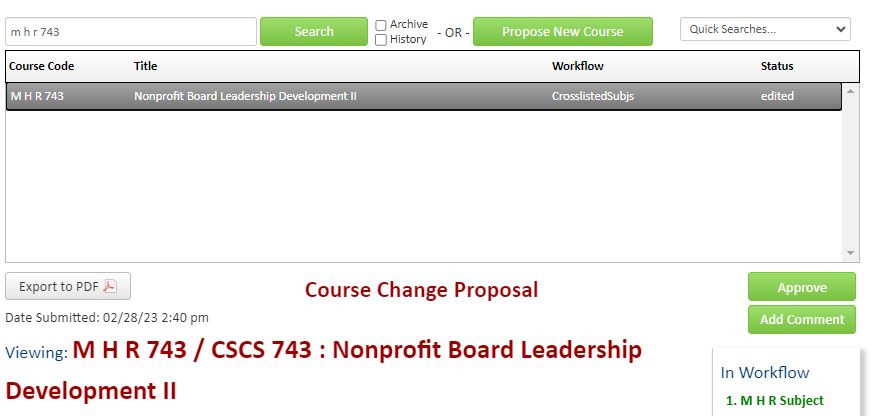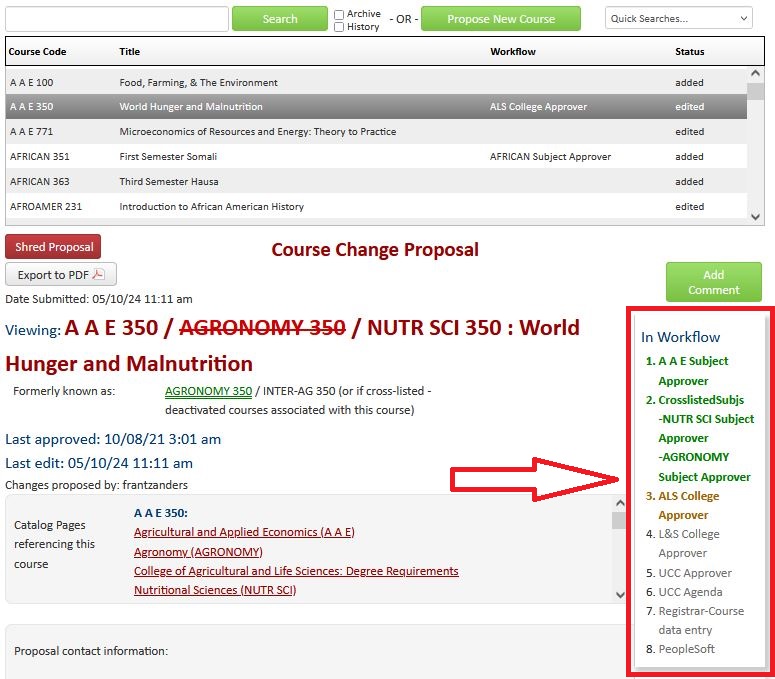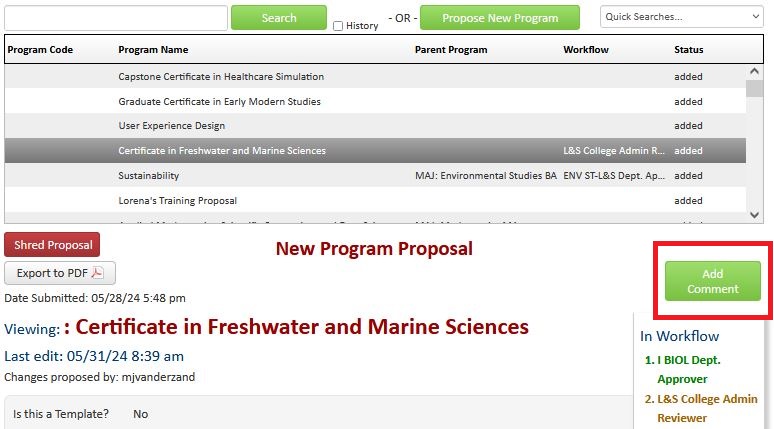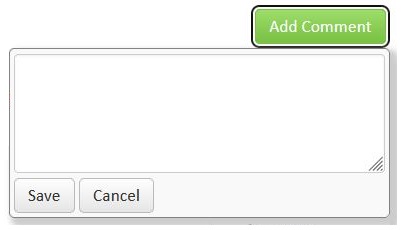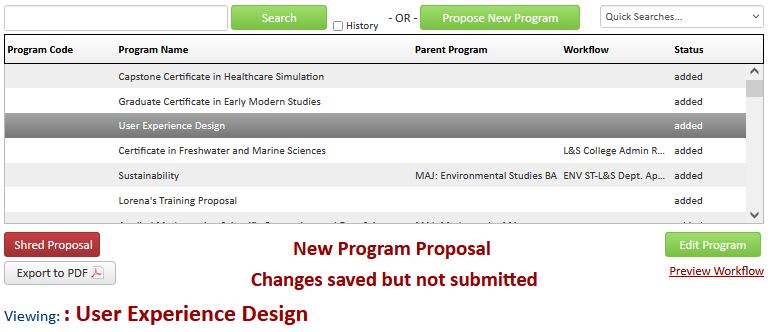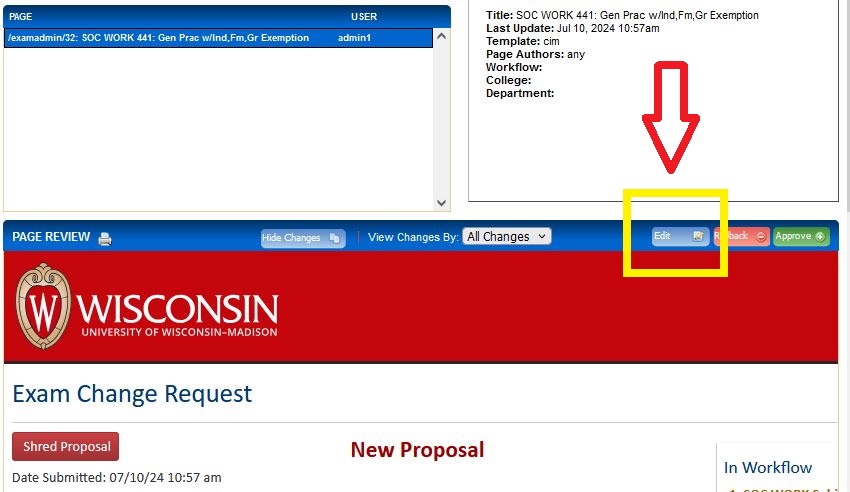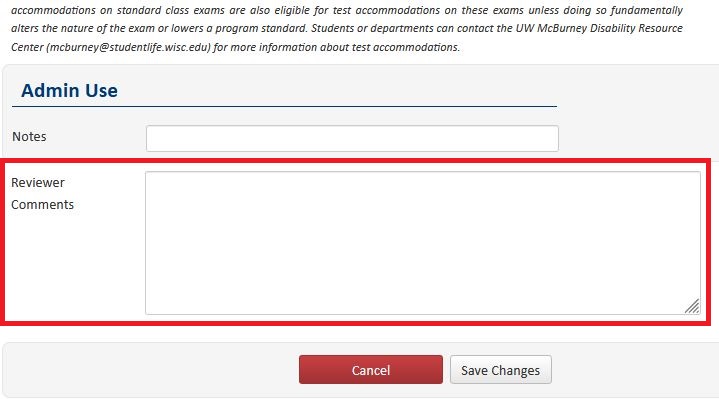Topics Map > Lumen Courses
Lumen Courses: Overview and System Functionality
- About Lumen Courses
- When do I need to submit a course proposal?
- Searching for a course or proposal
- How to start a course proposal
- Saving or submitting a proposal
- Lumen Courses workflow
- Checking the status of a proposal
- Email notifications
- Red/green markup
- Entering comments
- Removing a proposal from the approval process
About Lumen Courses
What is Lumen Courses?
Lumen Courses is a form in the Lumen suite of tools that facilitates proposals and approvals of governed content for any for-credit course offered at UW-Madison. All new courses, course changes, and course deactivation/discontinuation must be proposed through Lumen Courses.
Availability of Lumen Courses
Lumen Courses is available throughout the year (i.e. proposals may be worked on actively throughout the year; not limited to the academic year.)
Lumen Courses data
- When starting a change or deactivation/discontinuation course proposal, Lumen Courses pulls the current data from the Student Information System (SIS). End users can revise the existing content with the desired changes; Lumen Courses is the official repository for all course change data until approved and entered into SIS.
- Lumen Courses is the official repository of course data for new courses until approved and entered into SIS.
- Lumen Courses is the official repository of course learning outcomes.
Lumen Programs
The data from Lumen Courses (includes all current versions of a course plus any proposed revisions/new courses) populates the course information available in Lumen Programs from mid-October until mid-April. This allows governance to review a program proposal holistically with any yet-to-be-approved course data.
FYI about effective dating (when proposals take effect)
The first term available on the course proposal form determines when a course will show up in Guide and in SIS (scheduling).
When do I need to submit a course proposal?
- When proposing a new course.
- When deactivating/discontinuing a course.
- When you need to make a change to any of the following items, which apply at the catalog-level:
- Subject or Cross-listing(s)
- Catalog number (depending on the circumstances, you may be better off creating a new course and deactivating the existing; consult your school/college curriculum coordinator)
- Title
- Description
- Catalog-level requisites (section-level can be done when scheduling a course)
- Grading basis
- Component types (seminar, lecture, discussion, laboratory, independent study)
- Credits
- Repeatability
- Topic eligibility (if approved for topics, individual topics at the section-level do not require a course proposal)
- Course designations or attributes (honors, graduate, L&S breadth, L&S level, general education, workplace, foreign language)
- Learning outcomes
Searching for a proposal
The course catalog includes all active courses (approved and in SIS), new (not yet approved) courses, and discontinued (deactivated) courses that have had enrollment in 8 years.
Step-by-step how-to
- Navigate to the landing page for the proposal type. Requires UW login.
- Enter your search in the field to the left of the green Search button.

- This can be the program name (full or partial). Do not use abbreviations or terms not in the official SIS description.
- This can be the key (found at the bottom right of the proposal).
- New programs will not have a code. Searching with an asterisk (*) will pull up all proposals and the new proposals filter to the top. The text that displays will show up in the second column (program transcript description, course title, etc.)
- Hit enter on your keyboard or click the green Search button.

Tips and tricks for searching Lumen
- Click on the header bar will sort the proposals based on the column you select i.e. clicking status will sort all programs based on their status, added, edited, deleted.
- Use an asterisk (*) as a wildcard.
- "Math*" returns results starting with Math (Mathematics, Math for...)
- "*Math*" returns results with "Math" listed somewhere in the title (Certificate in Math, Data Science and Mathematics...)
- "*Math" returns results where the last word is Math
- The search looks at the Code and Title field. These fields only use the exact title/name and do not use abbreviations.
- GCRT* pulls all graduate/professional certificates
- MS* pulls all master's degrees starting with MS (MS, MSB)
- If you are looking for a specific type of proposal, use the Quick Searches drop-down. These have pre-defined queries by module i.e. Lumen Courses has a different drop-down than Lumen Programs.

- Characters, such as apostrophes, reduce search optimization e.x. *Women's* returns no results, but "Women*s" returns 6 items.
Specific to Lumen Courses Search Tips
- Subject short description (i.e. A A E, or COMP SCI) will return all courses in this subject.
- Lumen course key (found at the bottom right hand corner of the proposal) will return a specific course proposal.
- Subject short description plus catalog number, also known as course code, will return a specific course proposal. [subject short descr] [catalog number] (i.e. ART 100)
- Wildcards (the asterisk, *) broaden the search based on the placement.
- "MATH*" will find everything that starts with “MATH” (i.e." Mathematics for Agricultural and Applied Economics" or "MATH 112")
- "*MATH" everything that ends with “MATH” (i.e.: MATH 112, or "Basic Concepts of Math")
- "*MATH*" everything that contains “MATH” (i.e. "Actuarial Mathematics" or "Introduction to Discrete Mathematics")
- Using the wildcard with a catalog number, "*100" will return all courses numbered 100, any course ID that ends with 100, or any course key that ends with 100.
Ways that will not return results
- Using the subject numerical code (i.e. 778 for Political Science).
- Using the non-approved subject short description (i.e. CS for COMP SCI)
- Using special characters; this includes apostrophes. For example, searching for "women's" will search "women"; the apostrophe ends the search abilities.
Quick Searches
- Added courses = all new courses where there is an active proposal in the system that has not yet been completed
- Edited courses = all courses where a proposal has been edited.
- Deactivated courses = courses that are discontinued but have had enrollment in the past 8 years and therefor the number is not eligible for use on a new course.
- Deactivated & In Workflow = courses that have a deactivation proposal in workflow.

How to start a course proposal
New courses
- Click the green "Propose New Course" button. (highlighted in the image below in a light blue color)
- Address all the proposal elements. For help, see the appropriate help KBs.
- Agree and ensure the course meets the credit hour policy and regular and substantive interaction requirements.
- Add a sample syllabus that meets campus-standards and the University Curriculum Committees requirements.
- Submit to workflow.
Course changes
- Search for the course you need to revise.
- Click on the course in the "scrolly bar" (designated by the off-set white/gray lines)
- Click the green "Edit Course" button on the right side of the screen. (highlighted in the image below in the red color)
- Revise the course proposal, as needed. For help, see the appropriate help KBs.
- Agree and ensure the course meets the credit hour policy and regular and substantive interaction requirements.
- Add a sample syllabus that meets campus-standards and the University Curriculum Committees requirements.
- Submit to workflow.
Course deactivation (discontinuations)
- Search for the course you need to revise.
- Click on the course in the "scrolly bar" (designated by the off-set white/gray lines)
- Click the red "Deactivate" button on the left side of the screen. (highlighted in the image below in the dark blue color)
- Select the soonest term (it will be administratively changed to the current term for deactivation)
- Submit to workflow.
Saving or submitting a proposal
The software does not automatically save proposals.
There are three ways to save a proposal:
- Click the "floating save" button (stays at the bottom of the browser as you scroll).
- Scroll to the very bottom of the proposal and click the gray "Save Changes." This will save changes and close the edit window. This does not submit to workflow.

- Scroll to the very bottom of the proposal and click the green "Start Workflow." This will close the window and submit the proposal to workflow if all required elements have been filled in. The proposal cannot be edited again from the landing page; additional revisions must be made in workflow by an approver or rolled out of workflow for any user to edit.

Submitting to workflow
When you have finalized your edits and are ready to start the approval process, click the "Start Workflow" button which can only be done when editing a proposal. All required fields must be filled in. If they are not, the form will automatically bump you up to the element that has not been populated.
Canceling changes
If you determine you do not want to save change, click the red "cancel" at the bottom of the form. 
If you clicked the "floating save", canceling will remove all change made since the last save (when you clicked the floating save). If you need to remove all changes that have been made/revert the proposal back to the last approved version, the proposal must be shredded.
If you need to remove all changes that have been made, see the removal of a course proposal process (shredding) below.
Lumen Courses workflow
- Workflow includes "conditional" steps of workflow, where by answering specific questions additional steps are added for specific governance body review. See the "if applicable" to see which proposals are conditional.
- If one a "conditional" step's answer is revised when the course is in workflow, the proposal must be rolled out of workflow and resubmitted to include/exclude the workflow steps associated with the question.
- Technical problems with the course proposal system can be sent to lumen@provost.wisc.edu.
- See the How to take action on proposals in Lumen/Guide (using workflow) KB for more information.
Typical workflow steps
- Subject approver
- On course change proposals, a "for your information" email is sent to any program listing this course in the curriculum (Department Approver is notified) once the subject approves the course. This is not an approval step.
- Any subject listed in the "What subjects (if any) might be interested in this course?" will receive an email notifying them that a course proposal is advancing in workflow that may be of interest to them once the course is submitted to workflow. This is not an approval step. If there are concerns/support, comments may be added to the proposal once it is in workflow. Any issues must be resolved prior to advancing to the next step of workflow.
- Cross-list Subject approver (if applicable)
- School/College approver
- Cross-listed School/College approver (if applicable)
- L&S Curriculum Committee (if applicable)
- General Education Committee (if applicable)
- University Curriculum Committee
- Registrar (Student Information System)
Details about each step
Subject approver
- The subject approver role automatically includes the department chair (as listed in HRS; if the department chair does not have a role in HRS, they must be added there before being added to the approval workflow step in Lumen.
Cross-list Subject approver (if applicable)
- Any subject listed in the field "Select subjects that will be crosslisted" will receive an email to review and approve the course proposal in the cross-listed step.
- All subjects must sign off before the proposal advances.
- Approval in this step of workflow is different than every other approval in Lumen. Navigate to the Lumen Courses landing page and search for the course. An approve button will appear on the right hand side of the page above the workflow list.
-
Subjects and school/colleges listed in these roles may enter comments but may not rollback a proposal.
- The individual subject (or school/college) roles listed under the step will appear in gray text until approval has been entered and then the text will turn green. The approval path will not record which user in the role approved the proposal.
- After the last subject (or school/college) has entered approval, a system process advances the proposal to the next step. If there is no specific subject and school/college/division listed (i.e. there are no cross-list partners) then these steps (while they appear in the workflow list) are automatically skipped.
School/College approver
- The School/College approver (S/C) is the S/C that owns the department owning the subject. A subject may only reside in a single department.
- The departmental chair in this step of workflow is the dean/director of the school, college, institute, or division and anyone designated by the dean or director to approve proposals.
- If the course is cross-listed and one of the cross-listed subjects is in another S/C, that S/C will also need to sign off on the course.
Cross-listed School/College approver (if applicable)
- The related information for the CrosslistedCols step of workflow is the same as the CrosslistedSubjs step.
L&S Curriculum Committee (if applicable)
- If a course uses attributes or designations from the College of Letters & Science, it must be reviewed and approved by the appropriate committee. This includes:
- L&S Breadth
- LAS Credit
- Level
- Foreign Language
- If L&S is the School/College approver, it will only show up in workflow once (it will not show up once for the school/college approver and again for the attributes/designations approver). This single role is used both for courses where the department is part of L&S and where the proposal requests LAS, Breadth or Level course attributes.
- Workflow step: L&S College Approver
General Education Committee (if applicable)
- If a course uses general education attributes, it must be reviewed by the appropriate General Education Committee.
- If a course uses more than one of these attributes/designations, it must be approved by each body before advancing to the additional committee(s).
- If a course is for graduate/professional students only, these will not be applicable.
Attributes/Designations requiring additional review
- Communication A
- If "Communications Part A" is the response selected in the General Education field, the person(s) in this role review the proposal to determine whether it meets the criteria of this attribute.
- Workflow step: COM A Approver
- Communication B
- If "Communications Part B" or "Section Level Communications Part B" is the response selected in the General Education field, the person(s) in this role review the proposal to determine whether it meets the criteria of this attribute.
- Workflow step: COM B Approver
- Ethnic Studies
- If the question "Should this course be considered for the Ethnic Studies ... " is answered affirmatively the person(s) in this role review the proposal to determine whether it meets the criteria of this attribute.
- Workflow step: Ethnic Studies Approver
- Quantitative Reasoning Part A
- If "Quantitative Reasoning Part A" is the response selected in the General Education field, the person(s) in this role review the proposal to determine whether it meets the criteria of this attribute.
- Workflow step: QR-A Approver
- Quantitative Reasoning Part B
- If "Quantitative Reasoning Part B" is the response selected in the General Education field, the person(s) in this role review the proposal to determine whether it meets the criteria of this attribute.
- Workflow step: QR-B Approver
University Curriculum Committee (UCC)
- All courses must be reviewed and approved by the University Curriculum Committee.
- Courses are reviewed by Data, Academic Planning and Institutional Research prior to the committee review to ensure that proposals meet the minimum standards set by the committee before slating them for an agenda (UCC Approver step).
- Once a course is at the UCC Agenda step, they are slated for an upcoming agenda.
Registrar (Student Information System)
- Registrar-Deactivate Hold is for future effective dated deactivation proposals. Courses will sit here until the term they can be inactivated.
- Registrar-Course data entry is for proposals that have been approved at UCC and are waiting to be implemented in SIS.
- PeopleSoft is for the data entry in the course catalog, this is final "sync" step which will complete the proposal.
Checking the status of a proposal
If a proposal is "at rest" (the status is null/blank), there are no proposed revisions and the proposal is current. If there isn't a workflow step listed under the workflow column, the proposal is not in workflow. When a proposal is "in workflow," it lists the current step requiring sign-off in the scrolly bar. The example below is for courses, but the workflow status operates the same across the Lumen tools.
Step-by-step
The most up-to-date place to check the status of a proposal search for the proposal from the landing page:
- Navigate to the landing page for the proposal type. Requires UW login.
- Search for your proposal using the search functionality.

- Click on the proposal in the scrolly bar.

- Look at the "Workflow" column or the workflow steps on the right side of the proposal. If there is no status, the proposal is not in workflow.

Deciphering workflow by color
- The green steps mean the subject, school/college, or University Curriculum Committee has approved a course.
- Orange/Yellow means this is the current step of workflow.
- Gray means the proposal has not yet advanced to this step.

Status in Lumen Courses
There are four types of statuses:
- Added: a new course. This does not yet exist in SIS.
- Archived: a deactivated/discontinued course that no longer is active (the catalog number is available for re-use). These only show up when the "Archive" box is checked (next to the green Search button). For information on archived courses, see this KB.
- Deleted: a deactivated/discontinued course that has had been used on a student's record in the last 8 years and is not eligible for catalog number re-use.
- Edited: a course that has been edited. This course exists in SIS and is actively in the course catalog.
Email notifications
- If a course proposal is submitted for a course specifically listed in the curricular requirements of a program in Lumen Programs, those listed in the Dept. Approver role for that program receive an FYI email letting them know that there is a course change proposal in progress for the course. This is only an FYI.
- If the department reviews the course change proposal and has any questions or concerns they must contact the proposer of the course change. If it is determined that the change to the course necessitates a change to the program requirements, they must initiate a program change proposal.
- Those listed in an approver or notify role (FYI) will receive an email notification when the proposal reaches the relevant step in the approval process. This is the ONLY email that is sent until the proposal is fully approved and entered in the SIS course catalog.
- After approval, At that time an email notification is sent indicating the the proposal is complete and entered in SIS. This system does NOT send email notifications when a comment has been added. If a proposal needs to be edited the rollback function must be used. Rolling back a proposal includes a comment describing the needed edit and the proposal is sent back to the step indicated in the rollback action, is edited and resent (generating a new email notification requesting approval) to the next step in workflow.
- Users can click the link in the email notification to access the approval console page for that role (if they are in an approver role and not a cross-list partner). Note: The approval console page loads rather slowly, please be patient! You must select the relevant approver role from the Your Role: drop down box at the top middle right of the page.
How to filter emails
- All users in a workflow approver role must be included in the email notifications sent by the proposal system.
- Some users may wish to automatically direct these messages to a specific folder within their email account. General information regarding how to do this is available from the DoIT helpdesk. For consistency, it is highly recommended that you manage Inbox Rules via Outlook on the web. In addition, when you setup a rule in Outlook on the web the rule will be applied regardless of the client you are using.
- The subject lines start with:
- [Lumen Courses]
- [Lumen Badge]
- [Lumen Structures]
- [Lumen]
- [Lumen Programs]
- [Lumen Exams]
- The subject lines start with:
Red/green markup
The software utilizes "red/green markup" to visually indicate where content has changed in a change proposal.
- Red means the text has been removed. The red uses strike-through to indicate it is being removed for accessibility.
- Green means the text has been added. Green uses double lines under the text to indicate new text for accessibility.
Entering comments
- Comments can only be added to a proposal once it is in workflow.
- Anyone in with access to Lumen can enter a comment.
- Once a comment has been entered, they show up in the Reviewer Comments section at the very bottom of the proposal with the commenter's name, and the date entered.
- Comments cannot be removed.
Note: This system does NOT send an email notification when a comment is entered. It is recommended that you contact the person listed at the top of the proposal (courses only) or email those associated with the relevant workflow role. If the proposal needs to be edited, use the Rollback function.
How to add a comment from the proposal landing page
- Click on the proposal in the search results and verify it's in workflow. A green "Add Comment" will show up on the right side of the landing page under the scrolly bar.
- Click the "Add comment" button on the right side of the page above the workflow steps.
- Enter comment in the box.
- Click save.
A proposal not in workflow
How to add a comment while editing a proposal in workflow
When adding a comment to Lumen Programs or Lumen Courses, you may use the "Add Comment" button, or follow the instructions below.
To add comments in Lumen Exams, you must follow these instructions, which are only available to users with approving privileges.
- Navigate to the workflow step where the proposal currently resides in the Approve Pages console.
- Edit the proposal.
- Scroll to the bottom of the proposal.
- Add comment.
- Click "Save changes."

Removing a proposal from the approval process (shredding)
It is the responsibility of the proposer to ensure any proposal advances in a timely fashion.
Proposals that exceed the allotted time-frame per policy are "shredded" (removed/cancelled). Proposers are not notified of the shredding action. To ensure that your proposals do not get shredded, track them using the Lumen Tools viz1 (requires VPN and authentication) and ensure they progress through governance. Any proposal that reaches a university governance, DAPIR or Office of the Registrar workflow step will not be shredded.
If you have determined you no longer need a proposal (changes aren't needed, proposal was not approved), email lumen@provost.wisc.edu and specifying which proposal needs to be removed.
Notes
- Shredded proposals cannot be recovered, so retain a pdf version if you think you'll need it in the future.
- Shredded new courses will have no record of ever existing once shredded.
- Shredded change or deactivation (courses only) proposals will revert back to the most recently approved version of the proposal.
- Shredding can only happen to the entire proposal (i.e. specific parts of a proposal cannot be shredding while keeping other parts).

